KERALA SUTRA LIGHTING COLLECTION
|
 |
The history of Kerala, dates back more than several millennia. From as early as 3000 BC, Kerala had established itself as a major spice trade center. This level of connectivity and exposure transformed this region into a highly evolved society and a cradle for a wide range of craft practices. The key theme of this design project has been to re-discover, re-interpret and re-present these traditional objects & crafts practices of Kerala, as a collection of twenty light installations, to meet the demand and aspirations of a worldwide luxury market.
Our effort has been to narrate the story of Kerala in the most comprehensive manner, by stringing together five key elements that has given a framework to this design project. They are Land, Legend, Legacy, Love & Lifestyle. These five elements are like five chapters in a book that has been linked together by the thread of time, therefore the use of the metaphor "Sutra". The result is a fascinating overview not only of the treasures of the glorious past of Kerala but of its significance in the future. We present to you "Kerala- Sutra".
|
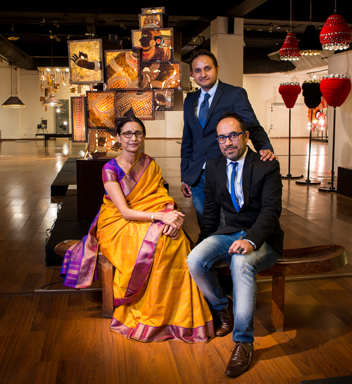
|
PURCHASE
ENQUIRY / REQUEST CATALOGUE info@sahilsarthak.com
|
Sahil Bagga & Sarthak Sengupta with Ms Anjana Somany |

|
| |
| |
| LEATHER SHADOW PUPPETS |
|
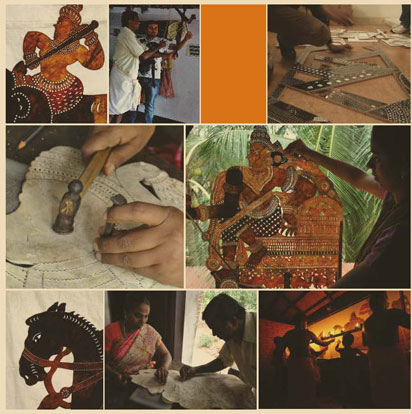 |
Tholpavakoothu, the ancient art-form of the shadow puppet theatre of Kerala, provides a continuation to the oral tradition through the performing arts. A compound of three Malayalam words, thol-leather, pava-doll, and kothu-play, this ritual performance is believed to have originated in the ninth century. Performances are held behind a stretched transparent cotton cloth screen with hanging oil lamps serving as the back light required to cast the shadows. The narrative is drawn mostly from Hindu scriptures. Shadows are deftly cast with the help of punched and painted leather puppets posing as legendary characters. The drama is completed by the accompanying traditional style of narration combined with singing. Typically made from deer, goat or buffalo skin, the puppets continue to be painted in vegetable dyes. Various hand-made punches create filigree type cutwork motifs on the leather. The lead puppeteer, a Pulavar or scholar, is well-versed in both vernacular and Sanskrit literature. The Kerala style of puppet making is on the decline and presently practiced by very few families residing in the Palakad and Thrissur districts of Kerala. Intricate workmanship, numerous punches and a darker colour palette, make the Kerala puppets distinctly different from their counterparts from the neighbouring regions.
|
| |
|
|
| |
|
|
 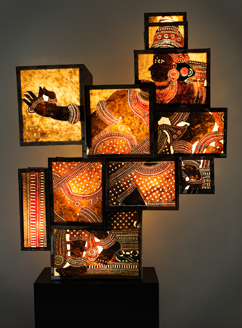 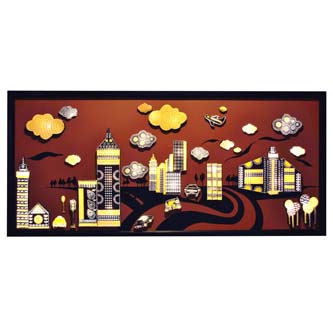 |
| LEATHER HORSE LIGHT PARTITION |
LEATHER RAMA RAVANA LIGHT PARTITION |
LEATHER CITYSCAPE WALL LIGHT INSTALLATION |
| |
|
PURCHASE
ENQUIRY / REQUEST CATALOGUE info@sahilsarthak.com
|
Copying of the
design is strictly prohibited". |

|
| |
| |
| MURAL PAINTING |
|
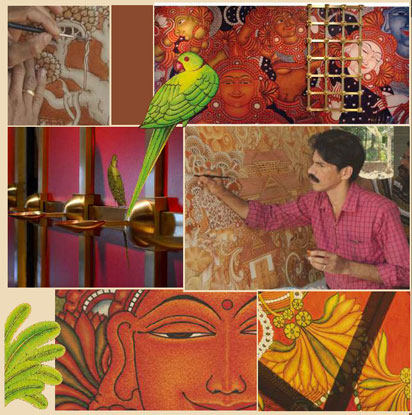
|
Mural paintings or frescoes can be dated back to the 2nd century BCE. Considered to be high art, they were predominantly religious in nature. They can be found on walls of monasteries, temples and palaces across the country. The high degree of skill and knowledge of the artists has baffled analysts through the ages. Among them the paintings of the Ajanta Caves are one of the earliest and the most famous. The earliest text dealing with the technique and theory of Indian painting is the Citrasutra in the Vishnudhamottara Purana; a text believed to have been written around the 4th century. A set of rules govern the painting of the human figure, types of men, different varieties of hair and eyes, poses of the body, methods of preparing the plastered walls, and conventions regarding the representations of gods, men, landscape, seasons etc. Distinction is made between sacred (satya, literally pure), lyrical (vainika) and secular (nagaras). Strict rules of proportion should be adhered to in the satya, while the lyrical should echo drama and music with the use of rasa.In Kerala, superb examples of ancient mural paintings can be found. Through generations, the Kerala mural artists have preserved this art. They have switched to paper and canvas helping the art form to flourish, albeit in a different avatar.
|
| |
|
| |
|
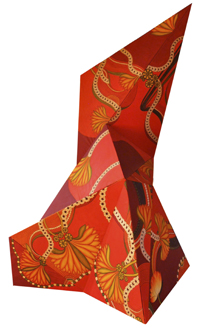 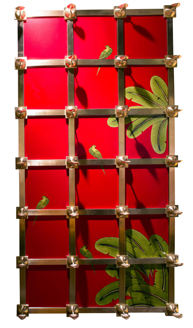 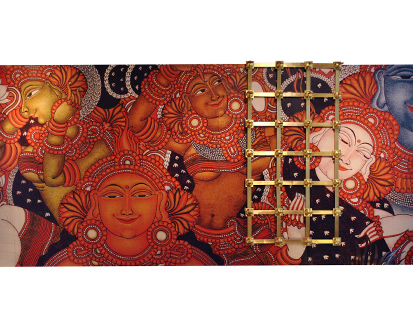 |
Faceted Floor Lamp in Painted Mural Fabric |
Diya Panel
|
Shringaar Wall Diya Panel |
| |
|
PURCHASE
ENQUIRY / REQUEST CATALOGUE info@sahilsarthak.com
|
Copying of the
design is strictly prohibited". |

|
| |
| |
| KATHAKALI |
| |
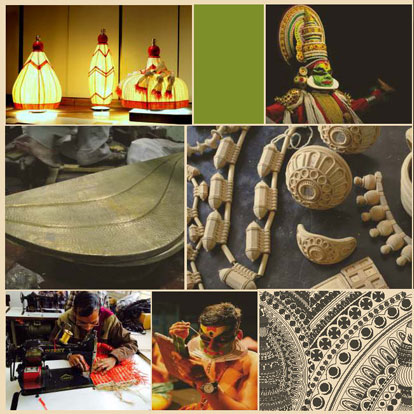 |
The origin of the dramatic classical Indian dance form Kathakali, is unique to the Southern state of Kerala. The name is derived from a combination of two Sanskrit words, katha meaning stories and kali meaning play or drama. The themes are drawn from Hindu mythological literature and characterized by stylized costumes, mask-like facial make up and the frequent use of mime. This endangered art form that enjoyed royal patronage is being kept alive by only a few groups of performers today.The most important element of Kathakali, is the facial expression of the performers. They are expected to convey the navarasams, loosely translated as nine tastes, feelings, or moods. These expressions are accentuated by an elaborate make-up code which can be classified into five basic sets, each differentiated by its predominant colour. Green or pachcha is used to portray noble male characters. Characters with a rajasik or evil disposition such as Ravana are portrayed with streaks of red on green. Excessively evil characters such as demons have red make-up and a red beard. The so-called tamasik or uncivilized characters such as hunters and woodsmen are represented with a black make-up base and a black beard. Finally, the women and ascetics have lustrous, yellowish faces.
|
| |
| |
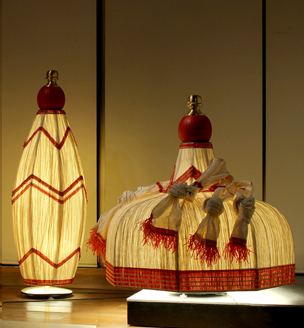 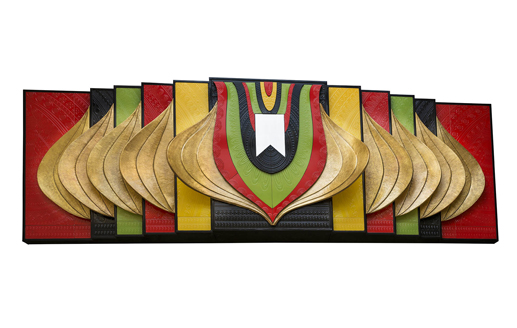 |
| KATHAKALI PAPER LIGHTS |
KATHAKALI WALL LIGHTS
|
| |
|
PURCHASE
ENQUIRY / REQUEST CATALOGUE info@sahilsarthak.com
|
Copying of the
design is strictly prohibited". |

|
| |
| |
| ARANMULA MIRRORS |
| |
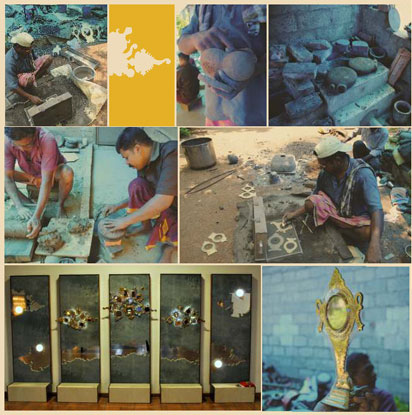 |
The Aranmula Mirrors or Aranmula Kannadi in Malayalam, are traditional handmade metal-alloy mirrors, and get their name from the Kerala village of Aranmula where they are made. Traditionally the mirrors were made reflective with the help of a metal alloy at a time when silvered glass mirrors were unknown. The exact recipe of this alloy has been passed down through generations and is guarded as a family secret by the traditional artisans. However, metallurgists suggest that the alloy is a mix of copper and tin in specific proportions which is applied to make a front surface reflective mirror, which eliminates secondary reflections and aberrations typical of the back surface silvered mirrors. Once this alloy is cast, it is polished for several days in a row to achieve their reflective surface. These unique metal mirrors are the result of Kerala's rich metallurgical traditions, and is of great cultural value. They are considered one among the eight auspicious items or Ashtamangalyam that make up a Kerala bride's trousseau. The mirrors are framed in handcrafted brass frames that are inspired by temple architecture motifs, nature and mythology. The artisans insist on packing each mirror in a felt clad jewellery box along with a mini pouch containing traditional polishing powder!
|
| |
| |
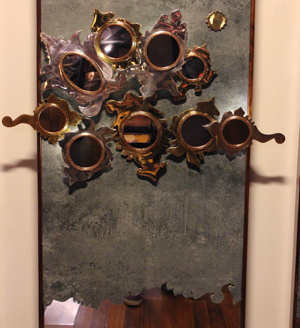 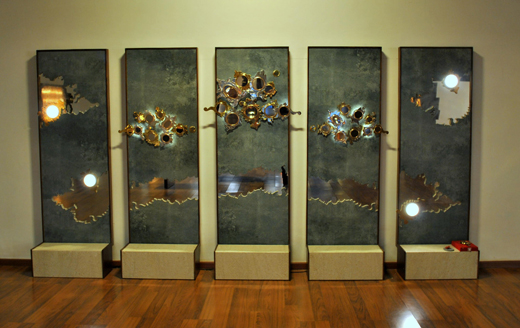 |
| |
ARANMULA CLOUD PANEL LIGHTS
|
| |
|
PURCHASE
ENQUIRY / REQUEST CATALOGUE info@sahilsarthak.com
|
Copying of the
design is strictly prohibited". |

|
| |
| |
| THEYYUM |
| |
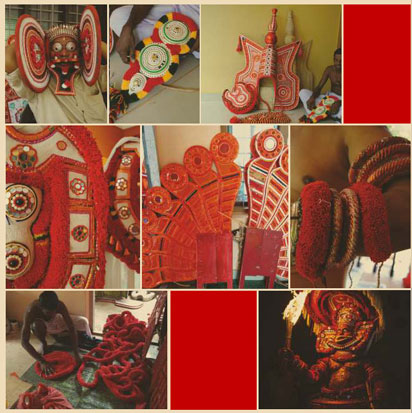 |
Theyyum is a popular ritualistic form of worship from the north of Kerala, predominant in the Kolathunadu area. It is a living cult and some historians believe that a large part of this extant folk ritual was practiced since the Neolithic, and Chalcolithic settlements. Also known as Malayanmar, or the one who metamorphoses into a deity, the performers belong to the so-called lower caste community. Legend has it that the performers get possessed by the spirit of the deity they invoke. The facial make-up, head gears, ornaments and costume of the performer, varies from one deity to the other. The frame that is worn by the performer is made in light white wood which is then painted and covered with colourful foil, pith, beads and mirrors. An important feature of any Theyyum attire are the handmade fluffy red wool ropes. These have a multi-use and are used for finishings and also as a layer to receive the stitched on silver ornaments. The contemporary installations have been created by artistically exploding and re-contextualizing these traditional dance attires to create unique pieces of both function and art.
|
| |
| |
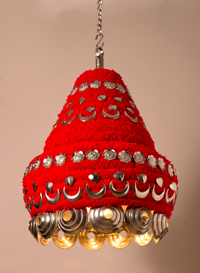 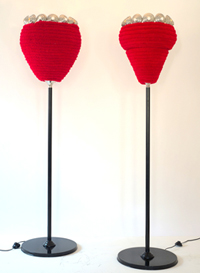 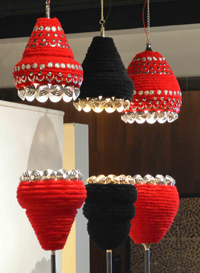 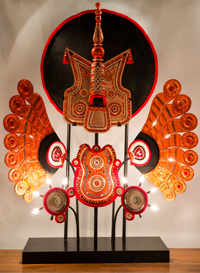 |
| THEYYUM FLOOR & PENDENT LIGHTS |
THEYYUM TOTEM |
| |
|
PURCHASE
ENQUIRY / REQUEST CATALOGUE info@sahilsarthak.com
|
Copying of the
design is strictly prohibited". |

|
| |
| |
| REPOUSSE |
|
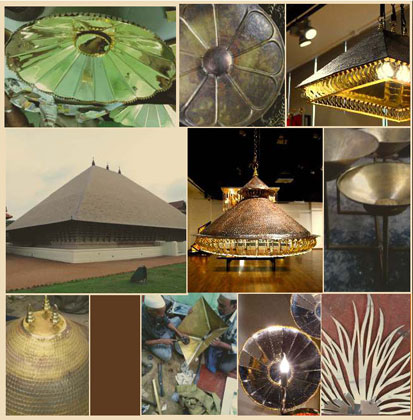 |
Kerala has a vibrant history of metal craft and has been famous for its metallurgical skills since antiquity. Repoussé, literally 'pushed back' in French, is a metal working technique in which a malleable metal is ornamented or shaped by hammering from the reverse side to create a raised design in low relief on the front. Repoussé techniques utilize the plasticity of metal, forming shapes by degrees on a continuous surface of sheet metal of essentially the same thickness. The process is relatively slow, but a maximum of form is achieved without the loss of any metal. It can also be referred to as embossing. The opposite of repoussé is called chasing, which is essentially done from the front of the work by sinking the metal. Very often the two are used in conjunction to finish the design. On an object crafted with repoussé, direct contact of the tools used is visible in the result while evidence of the working method is eliminated in other metal craft techniques. The designers' have imagined gopurams or typical shapes of rooftops of the homes and temples of Kerala as light installations. The Kerala shapes are an austere contrast to the towering structures found in the neighboring South Indian States. They have been created in the repoussé technique.
|
| |
| |
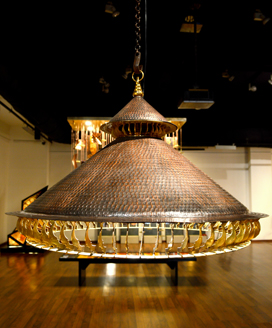 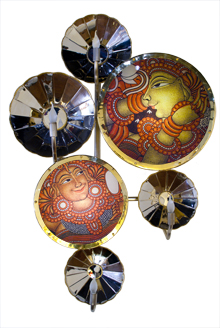 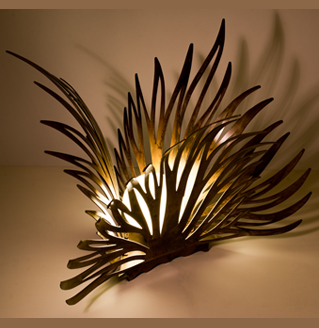 |
| Gopurams |
Prabha Wall and Floor Light
|
Lemon Grass Floor Lamp
|
PURCHASE
ENQUIRY / REQUEST CATALOGUE info@sahilsarthak.com
|
Copying of the
design is strictly prohibited". |

|
| |
| |
| METAL CASTING |
| |
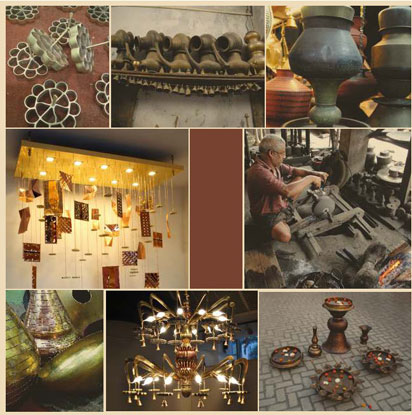 |
Metal casting processes have been known for thousands of years, and widely used for making weapons, tools, jewellery and sculptures. Molten liquid metal is poured into a mould, with a hollow cavity of the desired shape, and then allowed to cool and solidify. The solidified part, known as a casting, is broken out of the mould to finally refine the shape. Complex shapes that would be difficult or uneconomical to make by other methods are usually cast. The bell metal centers of Kerala are famous for their casting skills and dates back to several centuries. A form of bronze, it is an alloy that contains approximately a four is to one ratio of copper to tin. This unique metal provides a good medium for the craftsmen to make both religious artifacts as well as domestic utensils. As it is typified by its sonorous quality when struck, it is popularly used for making bells. The designers have re-contextualized typical forms of Kerala utensils into light installations. The urli, a shallow cooking vessel typical of Kerala, and the achapam, a thick mould for making sweets, provide the shape references. The installations with stacks of utensils draw inspiration from a copper market where space constraint orders stacking according to form.
|
| |
| |
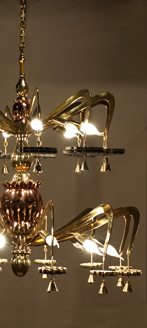 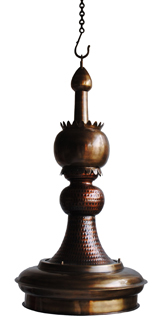 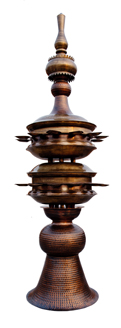 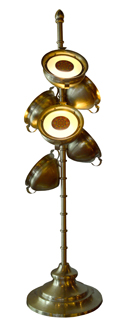  |
| AACHAPAM CHANDELIER |
COPPER MARKET PENDENT & FLOOR DEEPAM |
URLI LAMP & VASANTAM CHANDELIER
|
| |
|
PURCHASE
ENQUIRY / REQUEST CATALOGUE info@sahilsarthak.com
|
Copying of the
design is strictly prohibited". |

|
| |
| |
| NETTIPATTAM |
| |
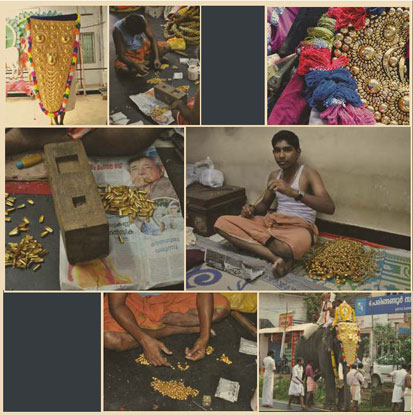 |
Nettipattam is the traditional caparison ornament worn by elephants during the Pooram festival in Kerala. Legend has it that the Nettipattam was designed by Lord Brahma for Airavath, the white elephant of Lord Indra. These glittering ornaments that adorn the forehead of the temple elephants are a graphical composition of gold plated hemispherical copper or brass beads, of different shapes and sizes. These are arranged together as pixel art, signifying the pantheon of Gods in Hinduism. Nettipattam ornaments are made by the atelier of master craftsmen who have served the great temples of Guruvayur and Thrissur since generations. This is one the first occasions where they have associated with designers to showcase that their craft can have an alternate application, more suitable to a contemporary audience. The result is a collection of hanging lamps, adorned with the Nettipattam arrangements, plated in silver. The cloth used is handloom malkha, which is essentially a blend of khadi and mulmul.
|
| |
| |
 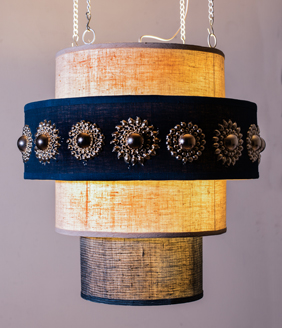 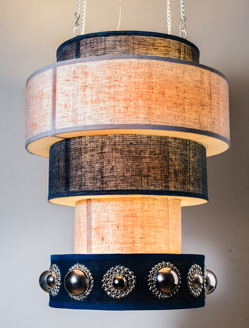 |
| NETTIPATTAM PENDENT LAMPS - LARGE - SMALL - MEDIUM |
| |
|
PURCHASE
ENQUIRY / REQUEST CATALOGUE info@sahilsarthak.com
|
Copying of the
design is strictly prohibited". |

|
| |